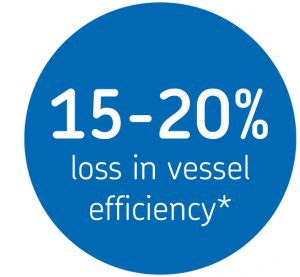Why is biofouling an issue?

*Estimated average efficiency loss due to deterioration in hull and propeller performance over a typical sailing interval. Source: MEPC 63/4/8
While a vessel is travelling, it is inevitable that various marine organisms, such as barnacles, algae, and tubeworms, will attach themselves to the submerged surfaces. Not only does this increase the wear and tear on ship hulls and propellers, it also significantly increases drag. Consequently, the vessel travels slower and consumes more fuel to compensate, adding to travel time, fuel costs, and greenhouse gas emissions. Another risk is that the organisms could enter a ship’s inner workings. If, for example, barnacles begin to grow inside engine pipes, they can clog them and cause the vessel to lose efficiency.
Fuel consumption is not the only environmental issue associated with biofouling. Some of the organisms that hitch a ride on ship surfaces are classed as aquatic invasive species (AIS). In light of stringent ballast water management regulations, the environmental impact of AIS is a much-debated topic right now. And this is where the two topics intersect: Zebra mussels, for example, are spreading through untreated ballast water
as well as hull fouling.
Two vectors for aquatic invasion
While the IMO and USCG have defined comprehensive regulations on ballast water management, biofouling has not yet received the same level of attention. This may come as surprising to some, especially when you compare the statistics. Research has shown that hull fouling accounts for 35 percent of IAS in US waters, compared to 20 percent from ballast water. In Australia, the difference is markedly higher, with reports of as much as 80 percent of invasive species originating from ships’ hulls in some areas.
Just one highly fouled vessel can carry up to 90 tons of growth
So while ballast water management still dominates headlines, there is growing awareness of the impact of biofouling. In 2011, the IMO adopted a set of Biofouling Guidelines to help provide a globally consistent approach. These recommend a set of best practices, including a ship-specific biofouling management plan and biofouling record book. While these guidelines are still voluntary at present, they will be reviewed in February 2020, as agreed by MEPC 72.
It is recommended to ship owners to have a Biofouling Management Plan with clear procedures and strategies. The economic benefit of doing so will improve vessel performance and lower the fuel consumption.
For some local and national governments, regulation is moving too slowly, prompting them to develop their own unilateral regulations based on the IMO’s guidelines. New Zealand, for example, introduced strict new rules in 2018 to ensure that vessels have ‘clean hulls’ upon arrival in the country. Vessels also have to submit information about their biofouling management practices, which can include anti-fouling documentation or records of hull maintenance work.
Collaborating to control the issue
Numerous organizations are working together to find solutions to biofouling. In December 2018, the IMO launched the GloFouling Project together with the United Nations Development Programme and the Global Environment Facility. This project aims to minimize the risk of spreading invasive aquatic species by reforming policy and building partnerships. At the same time, the shipping association BIMCO is leading a group of eight organizations to create an international standard for underwater hull cleaning. Expected to be finalized in autumn 2019, the standard is intended to ensure a safe, effective cleaning process and reduced environmental impact.
While the search for solutions continues, DNV GL recommends a Biofouling Management Plan, in line with the IMO’s guidelines. Not only will this prepare shipowners for the potential arrival of newer, stricter guidelines, but it also provides economic benefits through better vessel performance and reduced fuel consumption. In any case, it’s safe to assume that biofouling will become increasingly relevant in the future.
